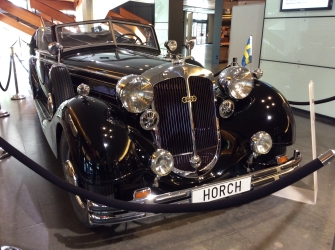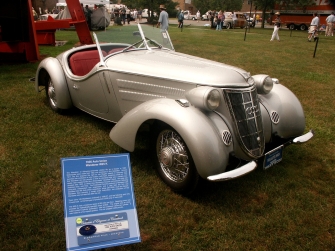

The origins of DKW go back to the early 1900s. Jorge Skafte Rasmussen, a Dane went to Saxony to study engineering at Chemnitz. With his friend Ernst he set up, in 1904, ‘Rasmussen & Ernst GmbH’ a company trading in exhaust steam oil traps and pipe fittings.
During the 1914-18 War Rasmussen experimented with a steam powered car: Dampf-Kraft-Wagen.
This project was abandoned at the end of the War for cost reasons.
Rasmussen’s next venture involved the production and successful marketing of a small (40cc) two stroke engine, originally intended as a power unit for toys, and given the name Des Knaben Wunch (every boy’s dream). The initials DKW being retained as the company name.
The engine was developed as a stationary power unit and soon found its way into vehicles made by other manufacturers. DKW also produced light weight motorcycles and bicycles powered by an auxiliary motor. The good performance given them by the DKW engines soon earned the nickname Das Kliene Wunder (the little wonder). Rasmussen’s company flourished, it was soon exporting motorcycles and engines all over the world, producing over one million machines by 1938 to become the world’s largest motorcycle manufacturer at that time.
Many companies were acquired by DKW, the most memorable was Audi-Werke AG, giving DKW increased manufacturing capacity and an established car manufacturing base. In 1928 DKW’s first production car appeared, a two seat roadster with conventional rear wheel drive, and a two stroke engine. The first production DKW with front wheel drive appeared at the 1931 Berlin Automobile Exhibition.
This DKW front, or F1 was to prove the forerunner of an automobile engineering concept which has retained its significant advantages over the years. Front wheel drive, independent suspension, a unit engine and gearbox and a light overall weight, giving reliability, economy, safety and performance.


In 1928 DKW’s first production car appeared, a two seat roadster with conventional rear wheel drive, and a two stroke engine. The first production DKW with front wheel drive appeared at the 1931 Berlin Automobile Exhibition.
In 1932, Horch and Wanderer were brought into the Rasmussen empire to form Auto-Union GmbH With its emblem of four intertwined rings representing DKW, Audi, Horch (below left) and Wanderer (below right). The only cars to bear the name Auto Union in the 30’s were the amazing V16 and V12 rear engined racers designed by Dr. Ferdinand Porsche and Eberan Eberhart, which with Mercedes gave the Third Reich complete domination in Grand Prix racing from 1934 to 1939.


The various small DKW cars, from F1 to F8 were to become the most popular of their type in Northern Europe, as well as being exported all over the world. Several Danish and Swedish companies had plans to make their own post-war adaptations of them. Saab, was the only one to be developed for modern times.
All but the Berlin factories of Auto-Union came within the Russian zone, (East Germany) when the war ended. Pre-war type 2 cylinder DKW’s being produced at Zwickau from 1948 to 1956 as IFA F8s, along with the pre-war 3 cylinder design as the IFA F9. Trabants and Wartburgs being a development of these. A new West German Auto-Union company was formed, retaining the DKW marque for its 1950 Meisterklasse (2 cylinder F89) and 1953 Sonderklasse (3 cylinder F91) produced in Dusseldorf and Ingolstadt, along with a range of motorcycles and light commercial vehicles. In 1958 a one litre version of the 3 cylinder DKW was introduced, named the Auto Union 1000, remaining in production until 1962. The 3 cylinder two stroke was a fine performer, and several formula junior racing cars used this unit.




DKWs were well known for rallying, winning the 1956 East African Safari Rally and the Finnish Thousand Lakes. The Auto Union 1000 had outright victory in the 1958 Safari and 1959 Acropolis Rallies and an F12 came third in the 2015 Monte-Carlo Historique Rally. See also DKW RACING in this website for more details about car and motorcycle competion sucesses.
By the late 50s Mercedes Benz had acquired 88% of Auto-Union shares. In 1958 the Junior model was produced. This and its successors went through to 1966, along with the F102 a more modern 1175cc two stroke machine, and the Munga, a 4 wheel drive ‘Jeep’ like vehicle.
In the mid 60s Volkswagen took control of Auto Union GmbH from Mercedes Benz, and the days of two stroke DKW and Auto Union cars were over. The F102 being adapted to take a four stroke engine to become the first post war Audi.
Details of a very good book showing the history of DKW, entitled DKW The history of a world marque may be seen by clicking on this link.
Adapted from the original text by Roger J. Lovell









